Geochemistry and Holocene Sedimentary Environment Evolution of Subaqueous Clinoform off Shandong Peninsula (Yellow Sea)
Abstract
:1. Introduction
2. Materials and Methods
2.1. Sample Collection and Segmentation
2.2. Description of the Sedimentary Facies
2.3. Grain Size Analyses
2.4. Major and Trace Element Analyses
2.5. AMS14C Analyses
3. Results
3.1. Age framework and Deposition Rate
3.2. Sediments Type and Grain Size Characteristics
3.3. Major and Trace Element Contents
4. Discussion
4.1. Correlation Analysis
4.2. Factor Analysis
4.3. Identification of Sediment Provenance
4.4. Paleo-Redox Evolution of Sedimentary Environment
5. Conclusions
Author Contributions
Funding
Acknowledgments
Conflicts of Interest
References
- Scourse, J.D.; Austin, W.E.N. Quaternary shelf sea palaeoceanography: Recent developments in Europe. Mar. Geol. 2002, 191, 87–94. [Google Scholar] [CrossRef]
- Yang, S.Y.; Jung, H.S.; Lim, D.I.; Li, C.X. A review on the provenance discrimination of sediments in the Yellow Sea. Earth-Sci. Rev. 2003, 63, 93–120. [Google Scholar] [CrossRef]
- Lim, D.; Jung, H.S.; Choi, J.Y. REE partitioning in riverine sediments around the Yellow Sea and its importance in shelf sediment provenance. Mar. Geol. 2014, 357, 12–24. [Google Scholar] [CrossRef]
- Lim, D.; Kim, J.; Xu, Z.; Jung, H.; Yoo, D.-G.; Choi, M.; Kim, S.-Y. Quantitative reconstruction of Holocene sediment source variations in the Yellow and northern East China Seas and their forcings. Mar. Geol. 2020, 430, 106345. [Google Scholar] [CrossRef]
- Chappell, J.; Omura, A.; Esat, T.; McCulloch, M.; Pandolfi, J.; Ota, Y.; Pillans, B. Reconciliaion of late Quaternary sea levels derived from coral terraces at Huon Peninsula with deep sea oxygen isotope records. Earth Planet. Sci. Lett. 1996, 141, 227–236. [Google Scholar] [CrossRef]
- Chappell, J. Sea level changes forced ice breakouts in the Last Glacial cycle: New results from coral terraces. Quat. Sci. Rev. 2002, 21, 1229–1240. [Google Scholar] [CrossRef]
- Yokoyama, Y.; Lambeck, K.; De Deckker, P.; Johnston, P.; Fifield, L. Timing of the Last Glacial Maximum from observed sea-level minima. Nat. Cell Biol. 2000, 406, 713–716. [Google Scholar] [CrossRef]
- Bard, E.; Hamelin, B.; Fairbanks, R.G. U-Th ages obtained by mass spectrometry in corals from Barbados: Sea level during the past 130,000 years. Nat. Cell Biol. 1990, 346, 456–458. [Google Scholar] [CrossRef]
- Clark, P.U.; Mix, A.C. Ice sheets and sea level of the Last Glacial Maximum. Quat. Sci. Rev. 2002, 21, 1–7. [Google Scholar] [CrossRef]
- Xue, C.; Qin, Y.; Ye, S.; Laws, E.A.; Wang, Z. Evolution of Holocene ebb-tidal clinoform off the Shandong Peninsula on East China Sea shelf. Earth-Sci. Rev. 2018, 177, 478–496. [Google Scholar] [CrossRef]
- Fairbanks, R.G. A 17,000-year glacio-eustatic sea level record: Influence of glacial melting rates on the Younger Dryas event and deep-ocean circulation. Nature 1989, 342, 637–642. [Google Scholar] [CrossRef]
- Stanley, D.J.; Warne, A.G. Worldwide Initiation of Holocene Marine Deltas by Deceleration of Sea-Level Rise. Science 1994, 265, 228–231. [Google Scholar] [CrossRef]
- Nakada, M.; Lambeck, K. Late Pleistocene and Holocene sea-level change in the Australian region and mantle rheology. Geophys. J. Int. 1989, 96, 497–517. [Google Scholar] [CrossRef] [Green Version]
- Milliman, J.D.; Qin, Y.S.; Ren, M.E.; Saito, Y. Man’s Influence on the Erosion and Transport of Sediment by Asian Rivers: The Yellow River (Huanghe) Example. J. Geol. 1987, 95, 751–762. [Google Scholar] [CrossRef]
- Liu, J.; Saito, Y.; Kong, X.; Wang, H.; Zhao, L. Geochemical characteristics of sediment as indicators of post-glacial environmental changes off the Shandong Peninsula in the Yellow Sea. Cont. Shelf Res. 2009, 29, 846–855. [Google Scholar] [CrossRef]
- Yang, Z.S.; Liu, J.P. A unique Yellow River-derived distal subaqueous delta in the Yellow Sea. Mar. Geol. 2007, 240, 169–176. [Google Scholar] [CrossRef]
- Liu, P.; Kong, X.; Saito, Y.; Yang, Z.; Wen, C. Subaqueous deltaic formation of the Old Yellow River (AD 1128–1855) on the western South Yellow Sea. Mar. Geol. 2013, 344, 19–33. [Google Scholar] [CrossRef]
- Patruno, S.; Hampson, G.; Jackson, C.A.-L. Quantitative characterisation of deltaic and subaqueous clinoforms. Earth-Sci. Rev. 2015, 142, 79–119. [Google Scholar] [CrossRef] [Green Version]
- Li, Y.; Li, A.-C.; Huang, P.; Xu, F.-J.; Zheng, X.-F. Clay minerals in surface sediment of the north Yellow Sea and their implication to provenance and transportation. Cont. Shelf Res. 2014, 90, 33–40. [Google Scholar] [CrossRef]
- Lan, X.H.; Chen, X.H.; Mi, B.B.; Li, R.H.; Qin, Y.C.; Wang, Z.B. Distribution pattern and source of major and trace elements in the central North Yellow Sea since late Pleistocene. Mar. Geol. Quat. Geol. 2015, 35, 1–10. (In Chinese) [Google Scholar]
- Fang, H.C.; Huang, P.; Zhou, Y.; Zhang, J.; Li, A.C.; Yan, J.S. Distribution and controlling factors of the major elements in surface sediments of the North Yellow Sea. Mar. Sci. 2015, 39, 108–116. (In Chinese) [Google Scholar]
- McManus, J.; Berelson, W.M.; Klinkhammer, G.P.; Johnson, K.; Coale, K.H.; Anderson, R.; Kumar, N.; Burdige, D.; Hammond, D.; Brumsack, H.J.; et al. Geochemistry of barium in marine sediments: Implications for its use as a paleoproxy. Geochim. et Cosmochim. Acta 1998, 62, 3453–3473. [Google Scholar] [CrossRef]
- Folk, R.L.; Ward, A.W.C. Brazos River bar; a study in the significance of grain size parameters. Sediment. Res. 1957, 27, 3–26. [Google Scholar] [CrossRef]
- Chen, J.S.; Wang, F.; Li, X.; Song, J.J. Geographical variations of trace elements in sediments of the major rivers in eastern China. Environ. Earth Sci. 2000, 39, 1334–1340. [Google Scholar] [CrossRef]
- Yang, S.; Li, C.; Jung, H.; Lee, H. Discrimination of geochemical compositions between the Changjiang and the Huanghe sediments and its application for the identification of sediment source in the Jiangsu coastal plain, China. Mar. Geol. 2002, 186, 229–241. [Google Scholar] [CrossRef]
- Yang, S.Y.; Li, C.X.; Jung, H.S.; Lim, D.I.; Choi, M.S. Geochemistry of trace elements in Chinese and Korean River sediments. Mar. Geol. Quat. Geol. 2003, 23, 19–24. (In Chinese) [Google Scholar]
- Yang, S.Y.; Jung, H.S.; Li, C.X.; Lim, D.I. Major element geochemistry of sediments from Chinese and Korean Rivers. Geochimica 2004, 33, 99–105. (In Chinese) [Google Scholar]
- Nesbitt, H.; Markovics, G.; Price, R. Chemical processes affecting alkalis and alkaline earths during continental weathering. Geochim. et Cosmochim. Acta 1980, 44, 1659–1666. [Google Scholar] [CrossRef]
- Nesbitt, H.W.; Young, G.M. Early Proterozoic climates and plate motions inferred from major element chemistry of lutites. Nat. Cell Biol. 1982, 299, 715–717. [Google Scholar] [CrossRef]
- Nesbitt, H.W.; Fedo, C.; Young, G.M. Quartz and Feldspar Stability, Steady and Non-Steady-State Weathering, and Petrogenesis of Siliciclastic Sands and Muds. J. Geol. 1997, 105, 173–192. [Google Scholar] [CrossRef]
- Gyana, R.T.; Sunil, K.S.; Ramaswamy, V. Major and trace element geochemistry of Bay of Bengal sediments: Implications to provenances and their controlling factors. Palaeogeogr. Palaeocl. 2014, 397, 20–30. [Google Scholar]
- Cheng, P. Sediment characteristics and transport processes of fine-grained material over the Northern Yellow Sea. Ph.D. Thesis, Institute of Oceanology, Qingdao, China, 2000. [Google Scholar]
- Wang, H.; Yang, Z.; Saito, Y.; Liu, P.; Sun, X.; Wang, Y. Stepwise decreases of the Huanghe (Yellow River) sediment load (1950–2005): Impacts of climate change and human activities. Glob. Planet. Chang. 2007, 57, 331–354. [Google Scholar] [CrossRef]
- Li, J.; Liu, S.; Feng, X.; Sun, X.; Shi, X. Major and trace element geochemistry of the mid-Bay of Bengal surface sediments: Implications for provenance. Acta Oceanol. Sin. 2017, 36, 82–90. [Google Scholar] [CrossRef]
- Sun, X.; Liu, S.; Li, J.; Zhang, H.; Zhu, A.; Cao, P.; Chen, M.-T.; Zhao, G.; Khokiattiwong, S.; Kornkanitnan, N.; et al. Major and trace element compositions of surface sediments from the lower Bengal Fan: Implications for provenance discrimination and sedimentary environment. J. Asian Earth Sci. 2019, 184, 104000. [Google Scholar] [CrossRef]
- Li, J.; Gao, J.; Li, J.; Wang, Z.; Yan, J.; Bai, F.; Cheng, Y. Distribution and controlling factors of major elements in sediments of the yalu river estuary. Mar. Geol. Quat. Geol. 2010, 30, 25–32. [Google Scholar] [CrossRef]
- Xu, L.-L.; Wu, D.-X.; Lin, X.-P.; Ma, C. The Study of the Yellow Sea Warm Current and Its Seasonal Variability. J. Hydrodyn. 2009, 21, 159–165. [Google Scholar] [CrossRef]
- Teague, W.J.; Jacobs, G.A. Current observations on the development of the Yellow Sea Warm Current. J. Geophys. Res. Space Phys. 2000, 105, 3401–3411. [Google Scholar] [CrossRef]
- Bao, X.W.; Li, N.; Yao, Z.G.; Wu, D.X. Seasonal variation characteristics of temperature and salinity of the north Yellow Sea. Period. Ocean. Univ. China (Nat. Sci. Ed.) 2009, 39, 553–562. (In Chinese) [Google Scholar]
- Liu, J.P.; Milliman, J.D.; Gao, S. The Shandong mud wedge and post-glacial sediment accumulation in the Yellow Sea. Geo-Marine Lett. 2001, 21, 212–218. [Google Scholar] [CrossRef]
- Yu, F.; Zhang, Z.; Diao, X.; Guo, J. Observational evidence of the Yellow Sea warm current. Chin. J. Oceanol. Limnol. 2010, 28, 677–683. [Google Scholar] [CrossRef]
- Bi, N.; Yang, Z.; Wang, H.; Fan, D.; Sun, X.; Lei, K. Seasonal variation of suspended-sediment transport through the southern Bohai Strait. Estuar. Coast. Shelf Sci. 2011, 93, 239–247. [Google Scholar] [CrossRef]
- Gao, S.; Park, Y.; Zhao, Y.; Qin, Y. Transport and resuspension of fine-grained sediments over the southeastern Yellow Sea. In Proceedings of the Korean-China international seminar on Holocene and late Pleistocene environments in the Yellow Sea Basin, Seoul, Korea, 20–22 November 1996; pp. 83–98. [Google Scholar]
- Zou, J.J.; Shi, X.F.; Liu, Y.G.; Liu, J.H. The geochemical records of paleoproductivity and paleoredox in the Sea of Japan since 48 ka. Acta Oceanol. Sin. 2010, 32, 98–109. (In Chinese) [Google Scholar]
- Zhao, X.K. Geochemical characteristics of black shale and paleoceanic implications of Niutitang Formation of Early Cambrian, Guizhou and Hunan Province. Master’s Thesis, China University of Geosciences (Beijing), Beijing, China, 2015. (In Chinese). [Google Scholar]
- Chen, W. Paleoenvironmental implication indicated by trace elements of the Ostracod shell for upper-middle section of Shangganchaigou Formation in the western Qaidam Basin. Master’s Thesis, Lanzhou University, Lanzhou, China, 2019. (In Chinese). [Google Scholar]
- Chaillou, G.; Schäfer, J.; Anschutz, P.; Lavaux, G.; Blanc, G. The behaviour of arsenic in muddy sediments of the Bay of Biscay (France). Geochim. et Cosmochim. Acta 2003, 67, 2993–3003. [Google Scholar] [CrossRef]
- Breit, G.N.; Wanty, R.B. Vanadium accumulation in carbonaceous rocks: A review of geochemical controls during deposition and diagenesis. Chem. Geol. 1991, 91, 83–97. [Google Scholar] [CrossRef]
- Tian, W.; Wang, C.S.; Bai, Y.S.; Li, P.J. Shale geochemical characteristics and enrichment mechanism of organic matter of the upper Devonian Shetianqiao sormation shale in Lianyuan Sag, Central Hunan. Earth Sci. 2019, 44, 3794–3811. (In Chinese) [Google Scholar]
- Xu, S.M.; Zhai, S.K.; Zhang, A.B.; Zhang, X.D.; Zhang, H.J. Distribution and environment significance of redox sensitive trace elements of the Changjiang Estuary Hypoxia Zone and its contiguous sea area. Acta Sediment. Sin. 2007, 25, 759–766. (In Chinese) [Google Scholar]
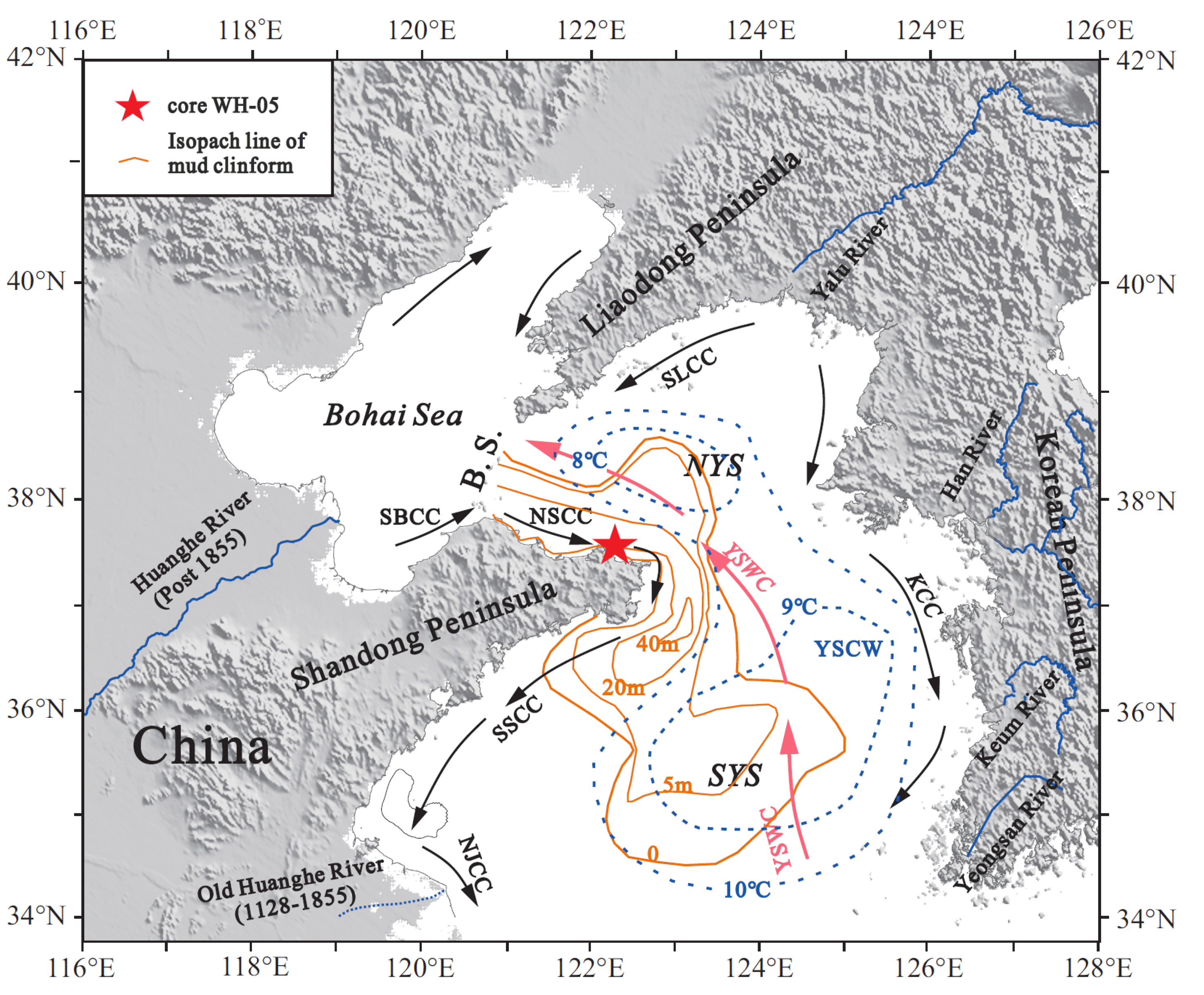

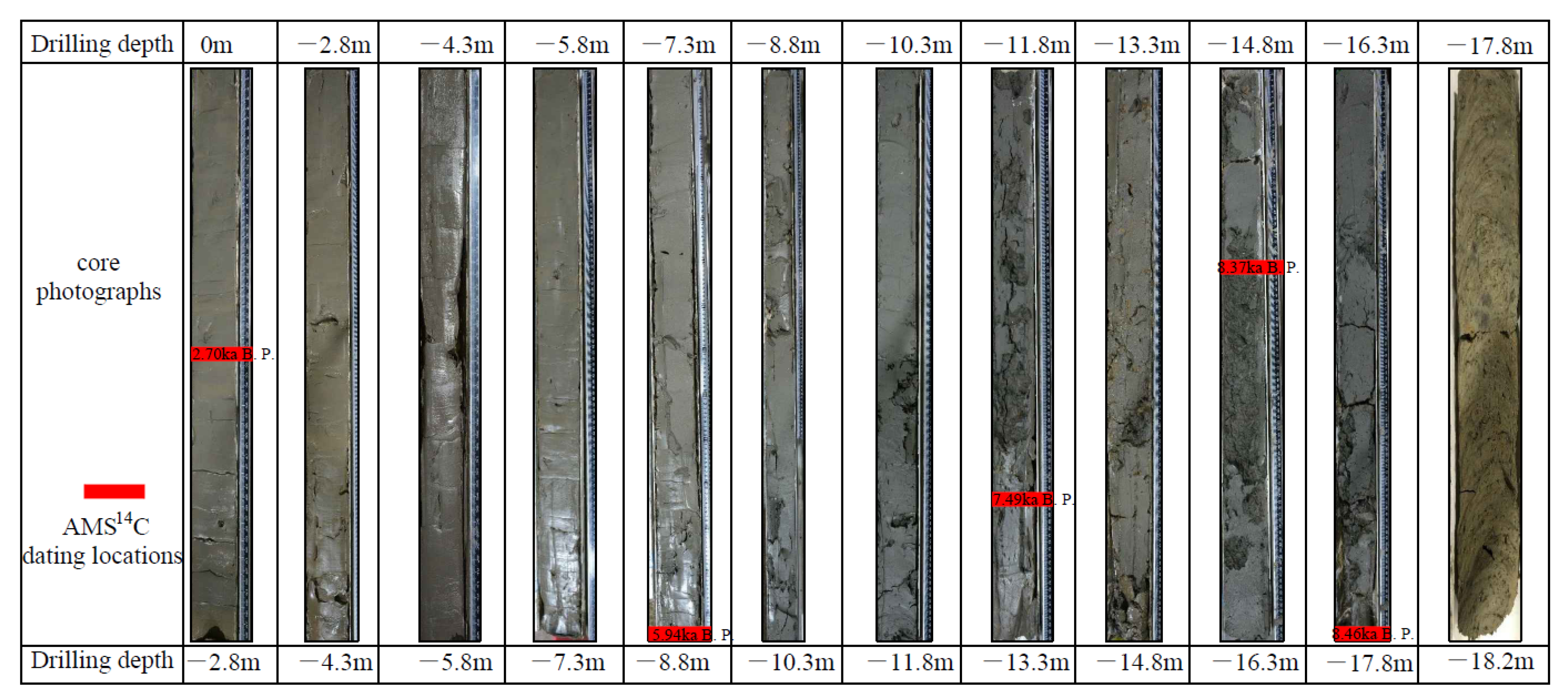
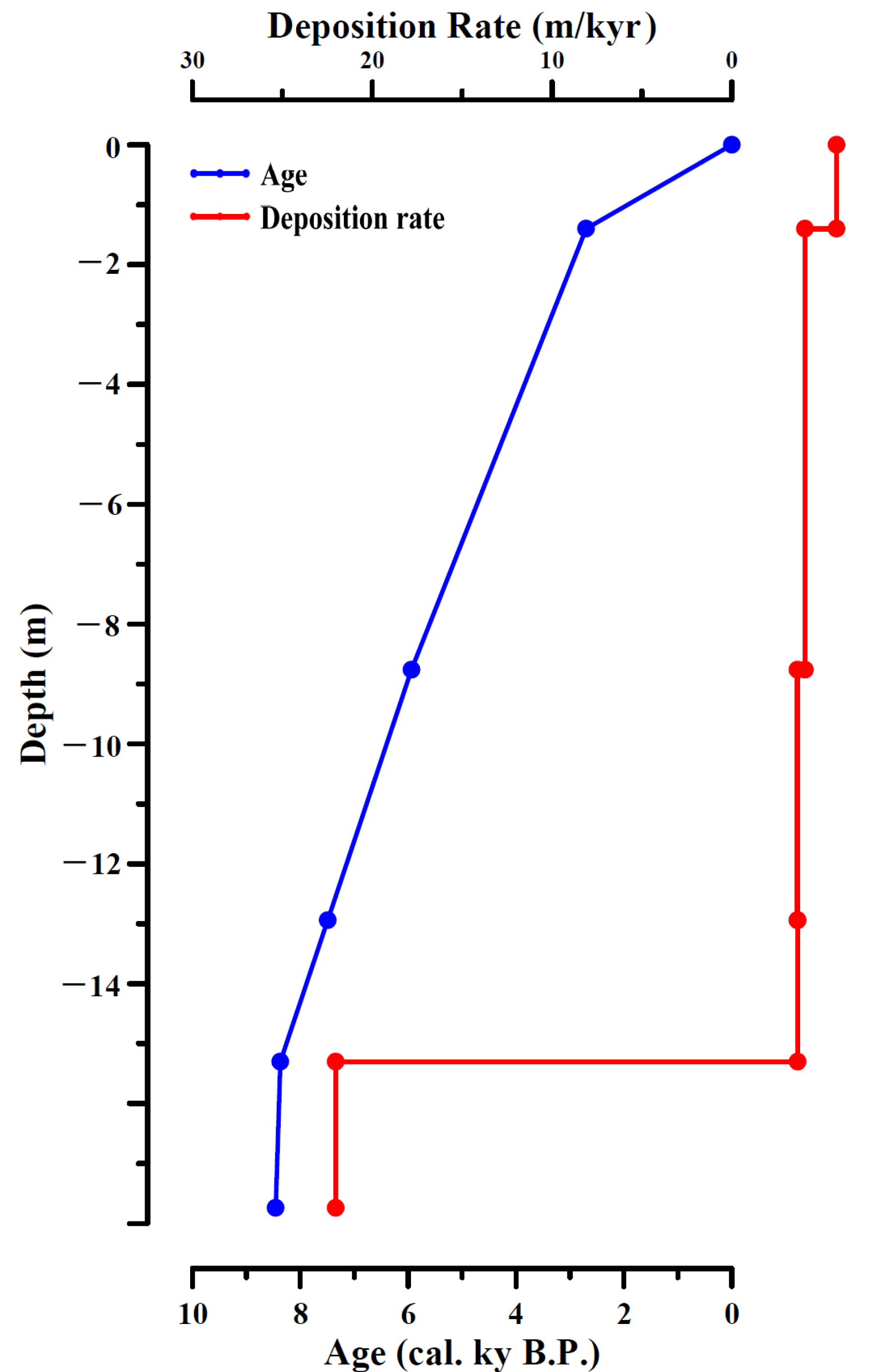
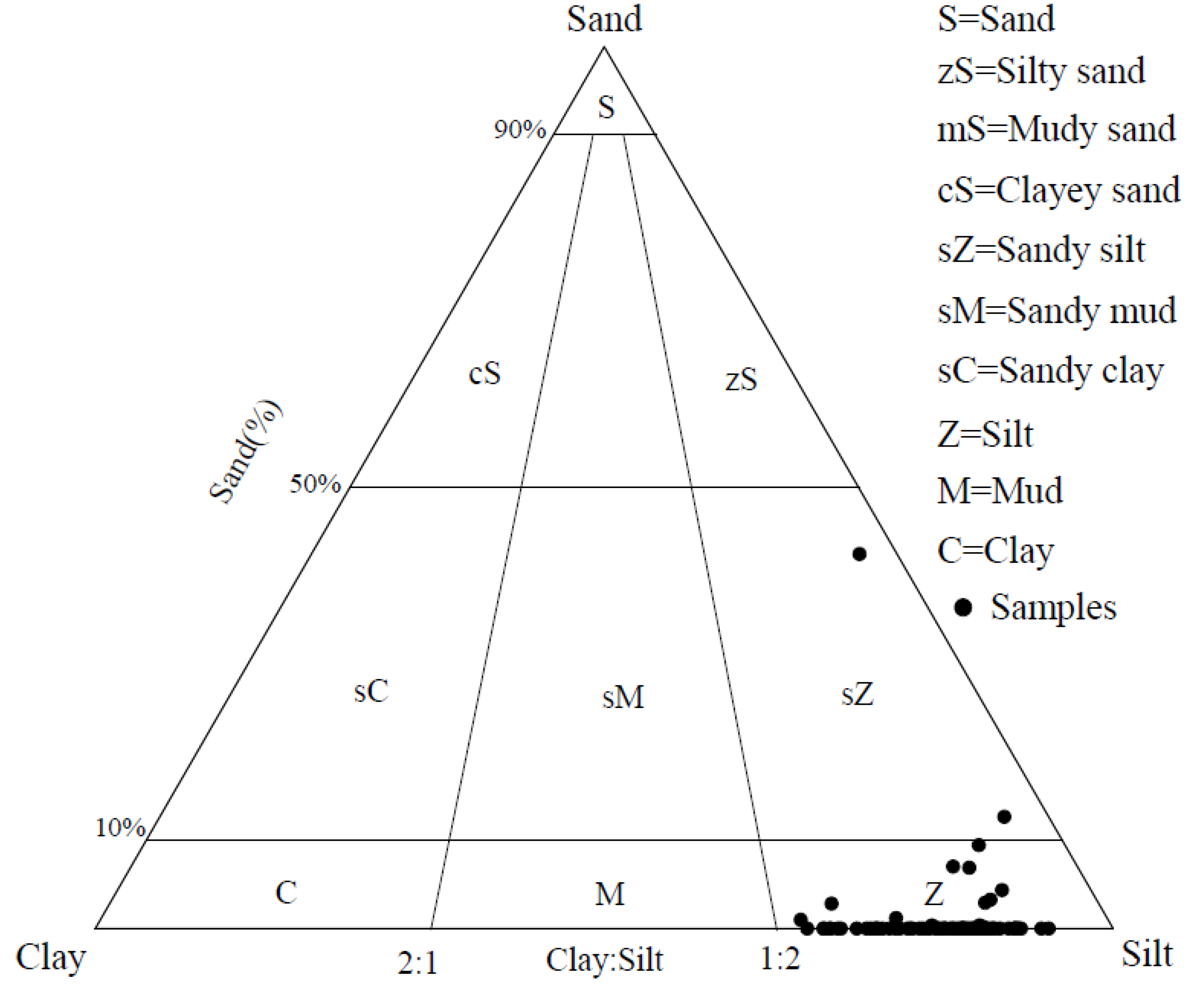
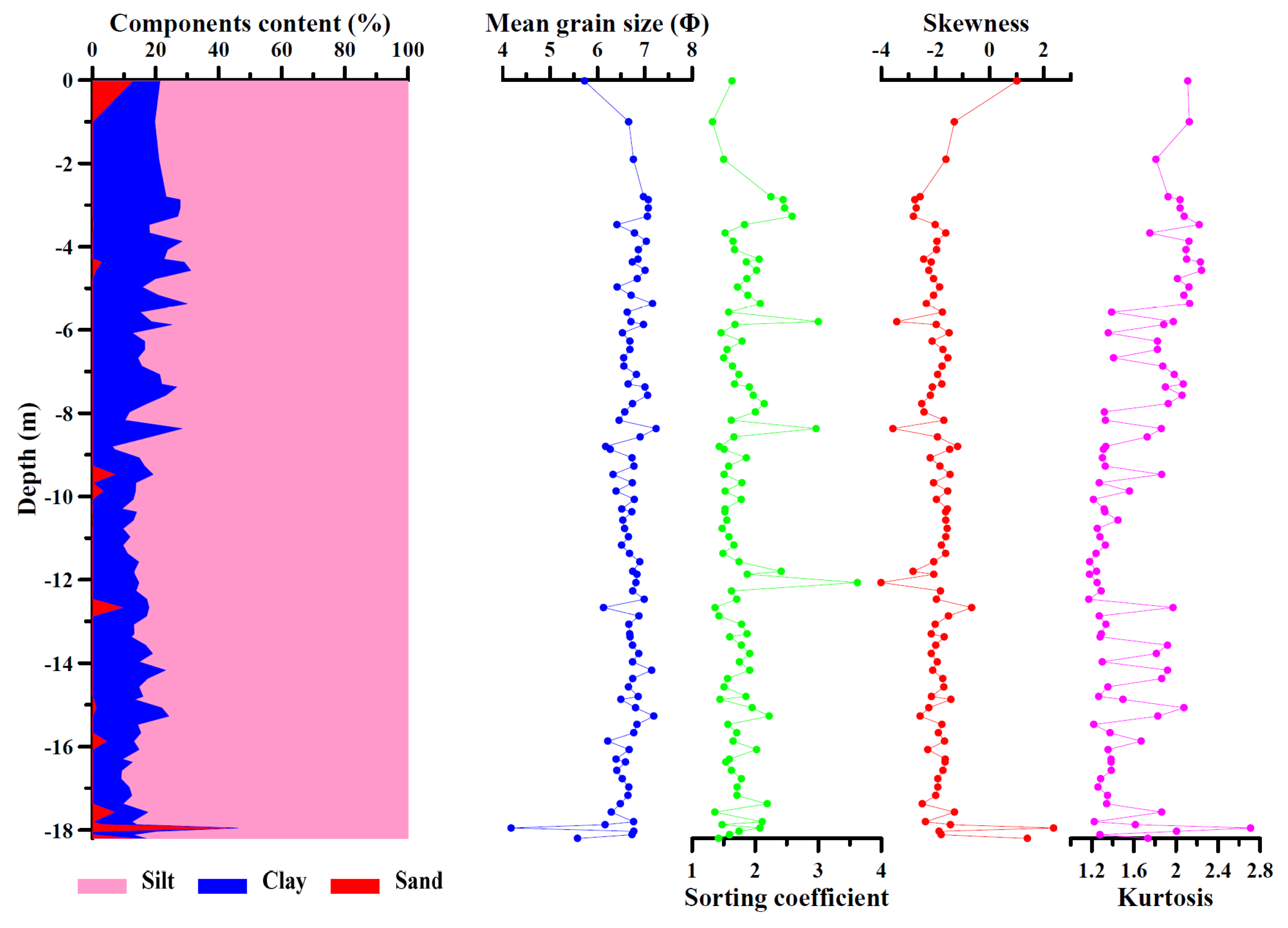
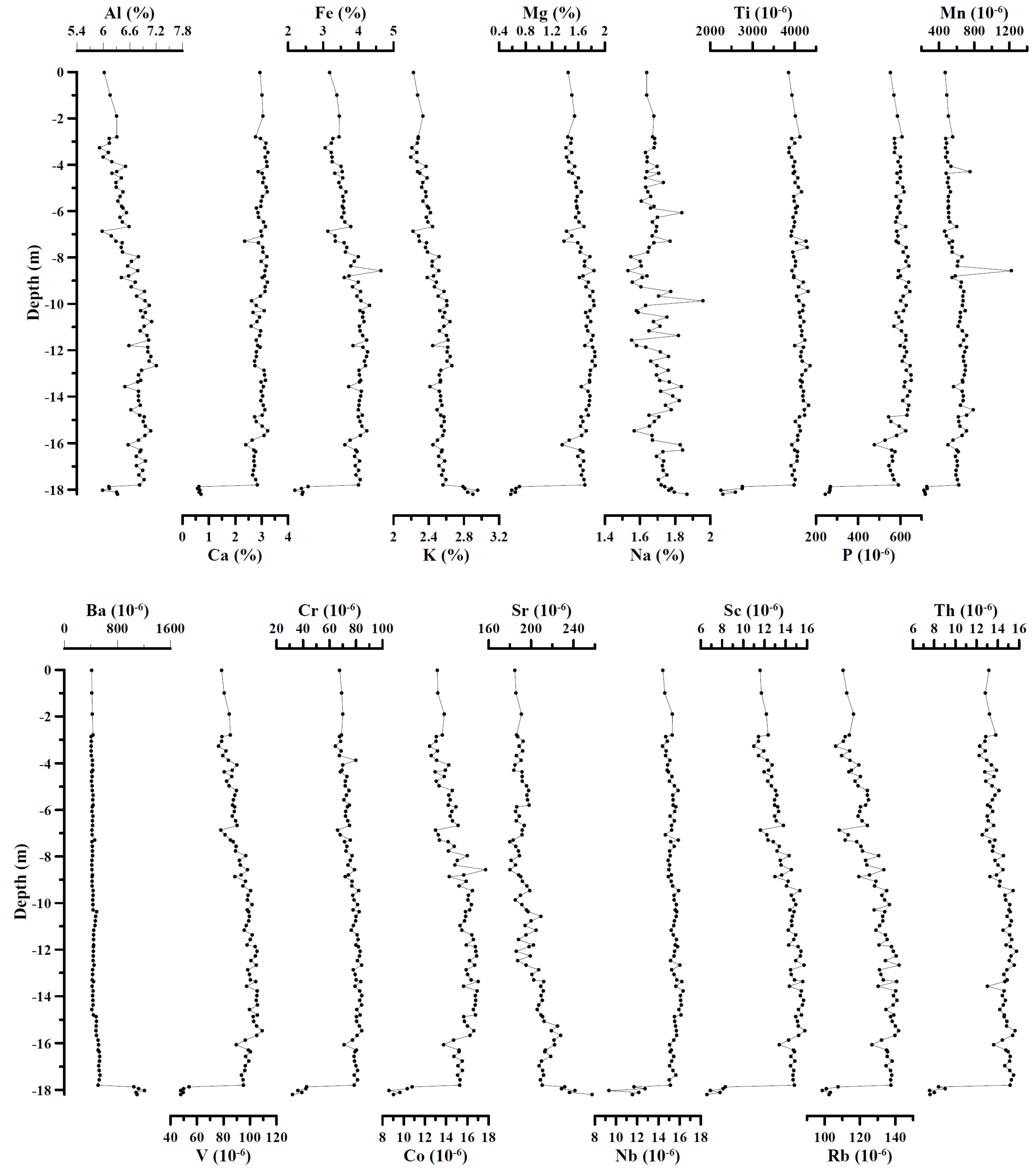
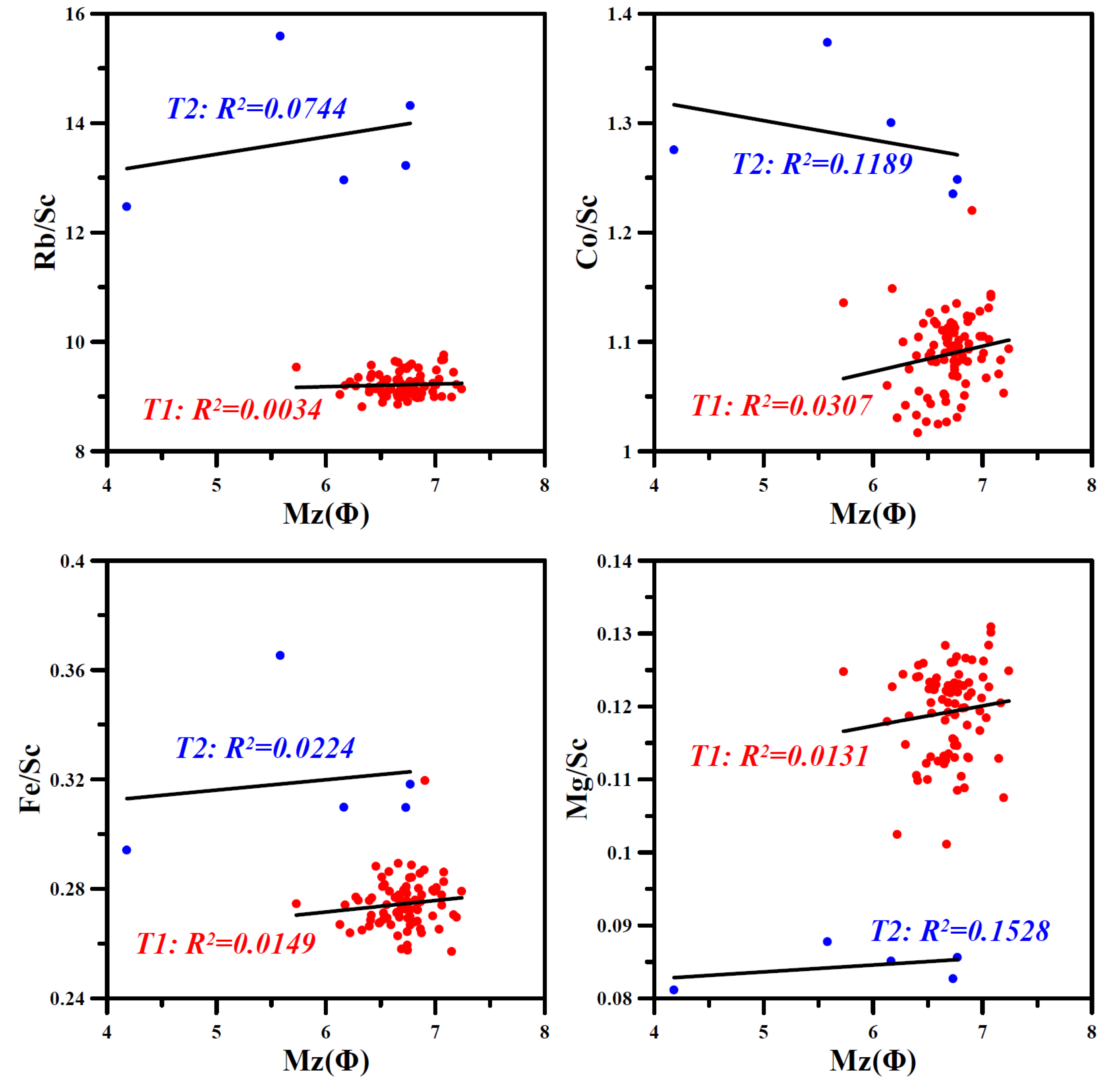
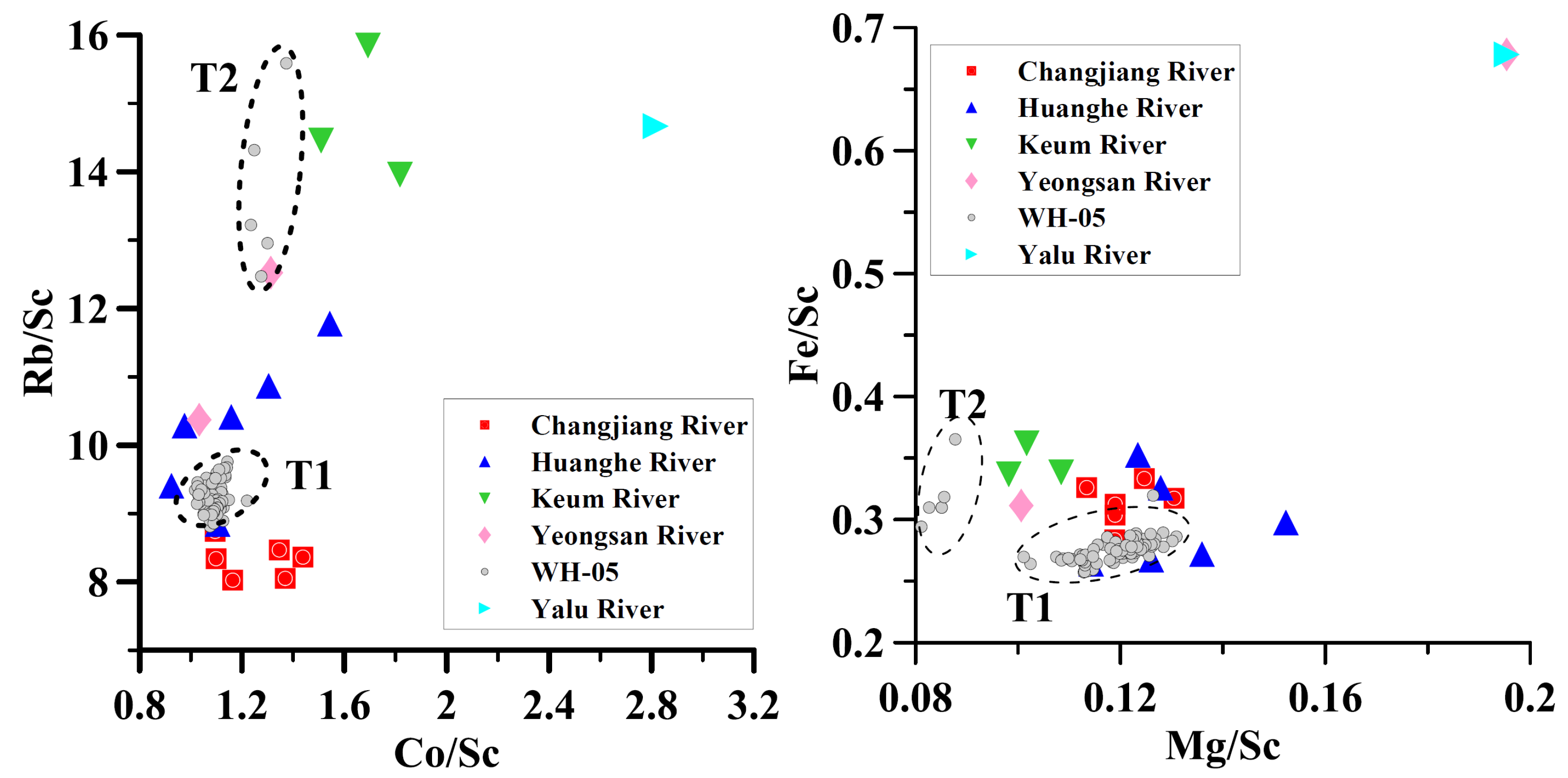
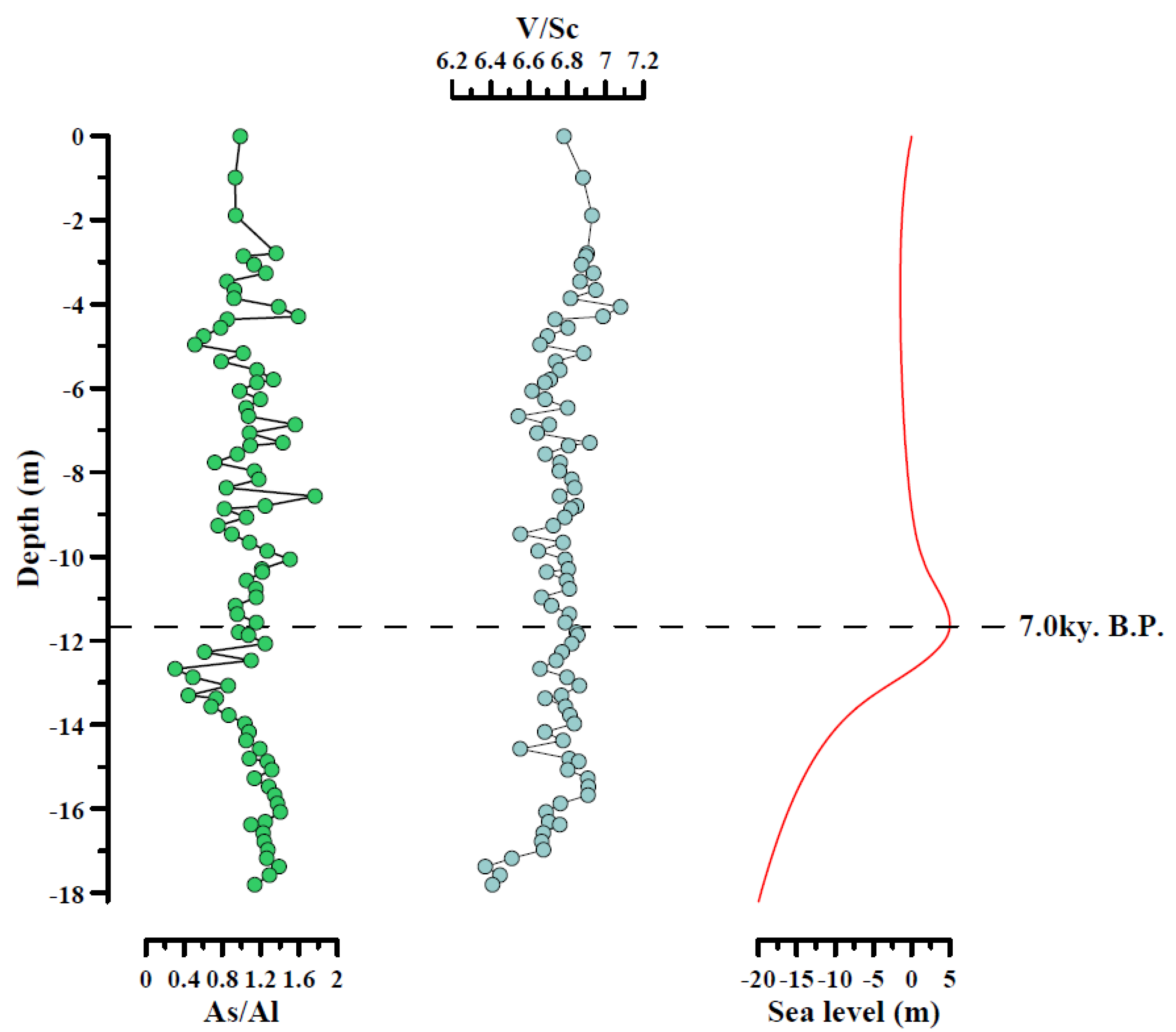
| Code Numbers (Beta) | Sample Depth (m) | Materials | AMS14C Age (a) | Calendar Age (a) | Deposition Rate (m/ka) |
|---|---|---|---|---|---|
| 551445 | −1.38~−1.43 | Benthic foraminifera | 2920 ± 30 B.P. | 2702 | 0.52 |
| 551446 | −8.74~−8.79 | Benthic foraminifera | 5550 ± 30 B.P. | 5940 | 2.27 |
| 551447 | −12.92~−12.97 | Benthic foraminifera | 7000 ± 30 B.P. | 7493 | 2.69 |
| 551448 | −15.28~−15.33 | Benthic foraminifera | 7910 ± 30 B.P. | 8372 | 2.68 |
| 551449 | −17.72~−17.77 | Benthic foraminifera | 8000 ± 30 B.P. | 8458 | 28.37 |
| Content of Each Fraction (%) | Grain Size Parameters | ||||||
|---|---|---|---|---|---|---|---|
| Clay | Silt | Sand | Mz (%) | δ | Sk | Ku | |
| Max | 30.2 | 93.7 | 42.5 | 7.2 | 3.6 | 2.4 | 2.7 |
| Min | 3.7 | 53.9 | 0.0 | 4.2 | 1.3 | −4.0 | 1.2 |
| Ave | 16.1 | 82.7 | 1.2 | 6.7 | 1.8 | −1.9 | 1.6 |
| STD | 6.1 | 6.4 | 5.0 | 0.4 | 0.4 | 0.8 | 0.4 |
| C. V. (%) | 37.7 | 7.7 | 413.2 | 5.9 | 20.6 | −44.1 | 22.0 |
| Elements | Core Sediments | River | ||||||||
|---|---|---|---|---|---|---|---|---|---|---|
| Max. | Min. | Average | STD | C. V. (%) | Changjiang | Huanghe | Keum | Yeongsan | Yalu | |
| Al * | 7.2 | 5.9 | 6.6 | 0.3 | 4.9 | 7.2 | 5.3 | 6.5 | 7.2 | 7.2 |
| Ca * | 3.2 | 0.6 | 2.8 | 0.6 | 20.0 | 3.3 | 3.7 | 0.6 | 0.5 | 2.3 |
| Fe * | 4.6 | 2.2 | 3.7 | 0.5 | 12.3 | 4.3 | 2.2 | 3.4 | 3.8 | 5.9 |
| K * | 3.0 | 2.2 | 2.5 | 0.2 | 6.1 | 2.1 | 1.8 | 2.1 | 2.3 | 2.9 |
| Mg * | 1.9 | 0.6 | 1.6 | 0.3 | 16.6 | 1.7 | 1.0 | 0.9 | 1.1 | 1.7 |
| Na * | 2.0 | 1.5 | 1.7 | 0.1 | 4.6 | 0.9 | 1.7 | 1.3 | 1.1 | 1.0 |
| Ti | 4362.4 | 2249.4 | 3985.2 | 376.3 | 9.4 | 5889.0 | 3138.0 | 3933.0 | 4546.0 | 4445.0 |
| P | 651.3 | 244.1 | 579.4 | 83.1 | 14.4 | 785.0 | 572.0 | 597.0 | 449.0 | --- |
| Mn | 1223.0 | 227.8 | 585.0 | 131.2 | 22.4 | 956.0 | 451.0 | 586.0 | 526.0 | --- |
| Ba | 1210.0 | 405.3 | 481.7 | 158.3 | 32.9 | 473.0 | 498.0 | 492.0 | 385.0 | --- |
| Li | 60.8 | 27.4 | 50.3 | 6.8 | 13.5 | 45.0 | 21.2 | 35.1 | 69.6 | --- |
| V | 109.2 | 47.8 | 91.5 | 13.0 | 14.2 | 105.5 | 50.8 | 64.2 | 86.7 | --- |
| Cr | 84.4 | 32.1 | 74.4 | 10.2 | 13.6 | 74.3 | 42.3 | 44.7 | 52.0 | 44.6 |
| Co | 17.7 | 8.6 | 14.8 | 1.8 | 12.0 | 17.3 | 8.7 | 14.7 | 15.7 | 24.5 |
| Ni | 47.0 | 18.6 | 34.6 | 4.9 | 14.0 | 40.7 | 19.3 | 26.1 | 32.8 | 40.2 |
| Cu | 34.2 | 11.2 | 27.4 | 5.2 | 19.1 | 50.7 | 14.2 | 27.3 | 20.4 | 42.3 |
| Zn | 92.2 | 36.6 | 78.8 | 11.7 | 14.8 | 106.5 | 33.9 | 73.5 | 76.6 | 231.0 |
| Sr | 257.6 | 180.0 | 200.2 | 14.9 | 7.5 | 146.7 | 218.7 | 148.7 | 119.0 | --- |
| Nb | 16.3 | 9.3 | 15.2 | 1.0 | 6.7 | 17.5 | 10.1 | 16.9 | 18.0 | --- |
| Pb | 29.5 | 18.8 | 23.6 | 2.5 | 10.4 | 38.5 | 17.7 | 36.7 | 26.8 | 40.0 |
| Sc | 15.8 | 6.6 | 13.5 | 1.9 | 14.2 | 13.8 | 7.6 | 9.0 | 13.5 | 8.7 |
| Rb | 142.2 | 98.7 | 126.4 | 11.2 | 8.9 | 114.9 | 76.9 | 131.7 | 153.4 | 127.6 |
| Th | 15.8 | 7.6 | 13.8 | 1.7 | 12.0 | 13.4 | 8.7 | 16.1 | 16.3 | --- |
| CIA*(T1) | 71.9 | 69.4 | 70.5 | 0.6 | 0.8 | 78.4 | 69.2 | 74.1 | 76.2 | 73.7 |
| CIA*(T2) | 67.1 | 65.6 | 66.6 | 0.5 | 0.8 | |||||
| Mz | Clay | Silt | Sand | Al | Ca | Fe | K | Mg | Na | Ti | P | Mn | Ba | Li | V | Cr | Co | Ni | Cu | Zn | Sr | Nb | Pb | Rb | Sc | Th | |
|---|---|---|---|---|---|---|---|---|---|---|---|---|---|---|---|---|---|---|---|---|---|---|---|---|---|---|---|
| Mz | 1.00 | ||||||||||||||||||||||||||
| Clay | 0.71 | 1.00 | |||||||||||||||||||||||||
| Silt | −0.02 | −0.68 | 1.00 | ||||||||||||||||||||||||
| Sand | −0.84 | −0.34 | −0.46 | 1.00 | |||||||||||||||||||||||
| Al | 0.08 | −0.42 | 0.52 | −0.15 | 1.00 | ||||||||||||||||||||||
| Ca | 0.51 | 0.31 | 0.10 | −0.50 | 0.21 | 1.00 | |||||||||||||||||||||
| Fe | 0.32 | −0.18 | 0.46 | −0.37 | 0.86 | 0.63 | 1.00 | ||||||||||||||||||||
| K | −0.35 | −0.54 | 0.28 | 0.30 | 0.53 | −0.66 | 0.08 | 1.00 | |||||||||||||||||||
| Mg | 0.42 | 0.01 | 0.34 | −0.45 | 0.65 | 0.84 | 0.92 | −0.23 | 1.00 | ||||||||||||||||||
| Na | −0.24 | −0.21 | 0.04 | 0.20 | 0.05 | −0.41 | −0.18 | 0.34 | −0.25 | 1.00 | |||||||||||||||||
| Ti | 0.44 | 0.15 | 0.19 | −0.43 | 0.48 | 0.88 | 0.80 | −0.46 | 0.93 | −0.25 | 1.00 | ||||||||||||||||
| P | 0.50 | 0.21 | 0.18 | −0.48 | 0.39 | 0.94 | 0.75 | −0.50 | 0.93 | −0.34 | 0.95 | 1.00 | |||||||||||||||
| Mn | 0.31 | −0.09 | 0.33 | −0.32 | 0.68 | 0.60 | 0.89 | 0.00 | 0.81 | −0.25 | 0.69 | 0.69 | 1.00 | ||||||||||||||
| Ba | −0.50 | −0.30 | −0.10 | 0.50 | −0.22 | −0.96 | −0.64 | 0.69 | −0.86 | 0.34 | −0.92 | −0.95 | −0.59 | 1.00 | |||||||||||||
| Li | 0.30 | −0.18 | 0.43 | −0.33 | 0.87 | 0.61 | 0.98 | 0.11 | 0.92 | −0.12 | 0.80 | 0.75 | 0.83 | −0.62 | 1.00 | ||||||||||||
| V | 0.37 | −0.09 | 0.41 | −0.41 | 0.80 | 0.70 | 0.96 | −0.03 | 0.93 | −0.14 | 0.86 | 0.81 | 0.83 | −0.71 | 0.97 | 1.00 | |||||||||||
| Cr | 0.39 | −0.01 | 0.33 | −0.41 | 0.70 | 0.78 | 0.92 | −0.19 | 0.95 | −0.19 | 0.92 | 0.87 | 0.79 | −0.79 | 0.93 | 0.97 | 1.00 | ||||||||||
| Co | 0.31 | −0.16 | 0.41 | −0.34 | 0.81 | 0.65 | 0.97 | 0.05 | 0.92 | −0.16 | 0.81 | 0.78 | 0.88 | −0.66 | 0.98 | 0.97 | 0.93 | 1.00 | |||||||||
| Ni | 0.31 | −0.16 | 0.42 | −0.34 | 0.82 | 0.62 | 0.95 | 0.07 | 0.89 | −0.10 | 0.78 | 0.74 | 0.83 | −0.61 | 0.96 | 0.97 | 0.93 | 0.97 | 1.00 | ||||||||
| Cu | 0.31 | −0.19 | 0.47 | −0.38 | 0.86 | 0.60 | 0.97 | 0.10 | 0.88 | −0.10 | 0.77 | 0.71 | 0.83 | −0.59 | 0.97 | 0.97 | 0.93 | 0.96 | 0.96 | 1.00 | |||||||
| Zn | 0.39 | −0.03 | 0.35 | −0.41 | 0.74 | 0.76 | 0.95 | −0.12 | 0.97 | −0.19 | 0.90 | 0.87 | 0.84 | −0.78 | 0.96 | 0.96 | 0.96 | 0.95 | 0.93 | 0.93 | 1.00 | ||||||
| Sr | −0.34 | −0.37 | 0.13 | 0.28 | 0.14 | −0.65 | −0.24 | 0.69 | −0.51 | 0.42 | −0.57 | −0.66 | −0.32 | 0.74 | −0.21 | −0.24 | −0.36 | −0.26 | −0.17 | −0.12 | −0.40 | 1.00 | |||||
| Nb | 0.34 | 0.07 | 0.20 | −0.34 | 0.52 | 0.81 | 0.79 | −0.38 | 0.88 | −0.17 | 0.95 | 0.88 | 0.67 | −0.86 | 0.81 | 0.87 | 0.91 | 0.83 | 0.81 | 0.78 | 0.89 | −0.45 | 1.00 | ||||
| Pb | −0.15 | −0.54 | 0.46 | 0.06 | 0.79 | −0.26 | 0.50 | 0.76 | 0.19 | 0.27 | 0.03 | −0.09 | 0.40 | 0.26 | 0.52 | 0.43 | 0.30 | 0.45 | 0.49 | 0.56 | 0.33 | 0.54 | 0.10 | 1.00 | |||
| Rb | 0.21 | −0.29 | 0.49 | −0.27 | 0.92 | 0.42 | 0.92 | 0.31 | 0.77 | 0.01 | 0.63 | 0.55 | 0.75 | −0.40 | 0.94 | 0.92 | 0.84 | 0.91 | 0.93 | 0.95 | 0.84 | 0.09 | 0.69 | 0.68 | 1.00 | ||
| Sc | 0.32 | −0.14 | 0.42 | −0.37 | 0.82 | 0.67 | 0.96 | 0.01 | 0.92 | −0.10 | 0.85 | 0.79 | 0.82 | −0.68 | 0.98 | 0.99 | 0.97 | 0.97 | 0.97 | 0.98 | 0.96 | −0.21 | 0.86 | 0.46 | 0.94 | 1.00 | |
| Th | 0.32 | −0.09 | 0.37 | −0.36 | 0.75 | 0.73 | 0.94 | −0.13 | 0.93 | −0.20 | 0.89 | 0.83 | 0.80 | −0.75 | 0.93 | 0.95 | 0.96 | 0.91 | 0.90 | 0.93 | 0.95 | −0.34 | 0.87 | 0.38 | 0.85 | 0.95 | 1.00 |
| Elements | Factor 1 | Factor 2 | Elements | Factor 1 | Factor 2 |
|---|---|---|---|---|---|
| Fe | 0.982 | 0.158 | Mg | 0.862 | 0.478 |
| Li | 0.976 | 0.140 | Mn | 0.842 | 0.208 |
| Cu | 0.959 | 0.135 | Nb | 0.722 | 0.526 |
| Rb | 0.951 | −0.076 | Ti | 0.713 | 0.615 |
| Co | 0.948 | 0.202 | K | 0.244 | −0.922 |
| Sc | 0.945 | 0.225 | Ca | 0.505 | 0.861 |
| Al | 0.939 | −0.310 | Ba | −0.510 | −0.828 |
| Ni | 0.939 | 0.166 | P | 0.656 | 0.712 |
| V | 0.936 | 0.268 | Sr | −0.121 | −0.706 |
| Zn | 0.909 | 0.356 | Pb | 0.618 | −0.667 |
| Th | 0.899 | 0.325 | Na | −0.101 | −0.420 |
| Cr | 0.873 | 0.398 | |||
| Variance (%) | 62.89 | 24.25 | Variance (%) | 62.89 | 24.25 |
Publisher’s Note: MDPI stays neutral with regard to jurisdictional claims in published maps and institutional affiliations. |
© 2021 by the authors. Licensee MDPI, Basel, Switzerland. This article is an open access article distributed under the terms and conditions of the Creative Commons Attribution (CC BY) license (https://creativecommons.org/licenses/by/4.0/).
Share and Cite
Zhu, Y.; Xu, Y.; Liu, M.; Lin, Z.; Zhu, L. Geochemistry and Holocene Sedimentary Environment Evolution of Subaqueous Clinoform off Shandong Peninsula (Yellow Sea). Minerals 2021, 11, 1209. https://doi.org/10.3390/min11111209
Zhu Y, Xu Y, Liu M, Lin Z, Zhu L. Geochemistry and Holocene Sedimentary Environment Evolution of Subaqueous Clinoform off Shandong Peninsula (Yellow Sea). Minerals. 2021; 11(11):1209. https://doi.org/10.3390/min11111209
Chicago/Turabian StyleZhu, Yingtao, Yongchen Xu, Mingyang Liu, Zhaobin Lin, and Longhai Zhu. 2021. "Geochemistry and Holocene Sedimentary Environment Evolution of Subaqueous Clinoform off Shandong Peninsula (Yellow Sea)" Minerals 11, no. 11: 1209. https://doi.org/10.3390/min11111209
APA StyleZhu, Y., Xu, Y., Liu, M., Lin, Z., & Zhu, L. (2021). Geochemistry and Holocene Sedimentary Environment Evolution of Subaqueous Clinoform off Shandong Peninsula (Yellow Sea). Minerals, 11(11), 1209. https://doi.org/10.3390/min11111209





